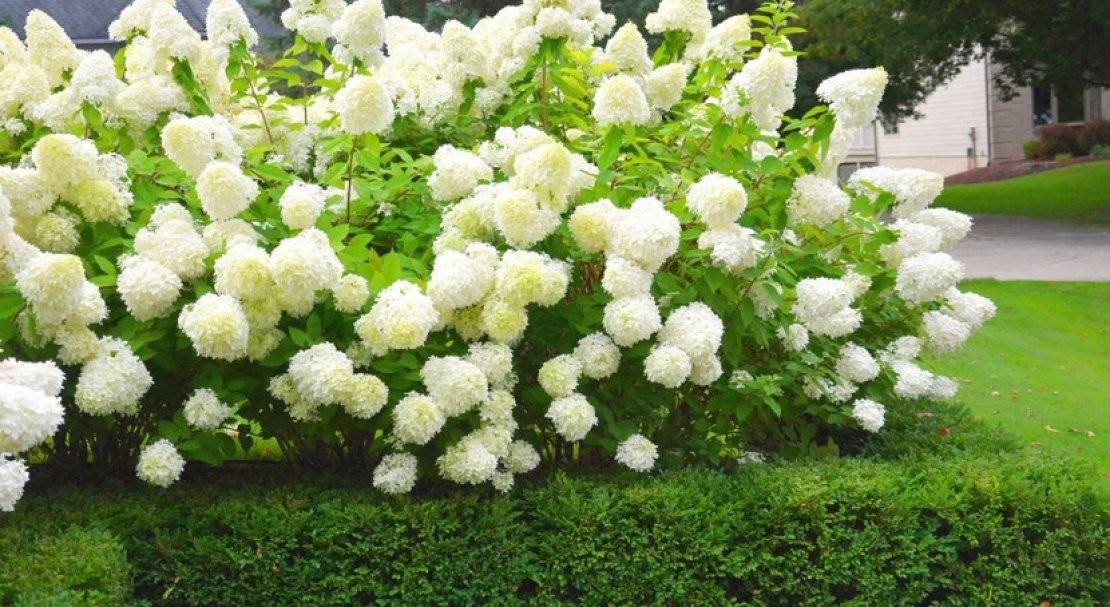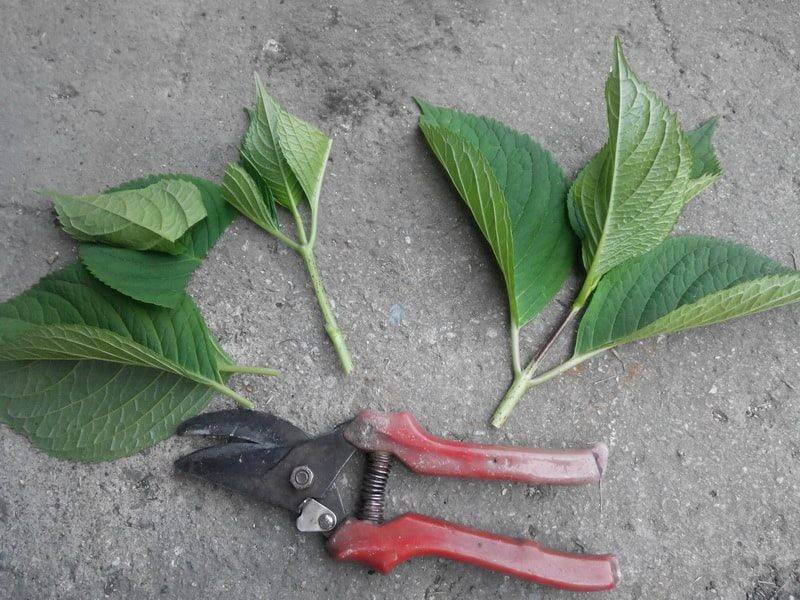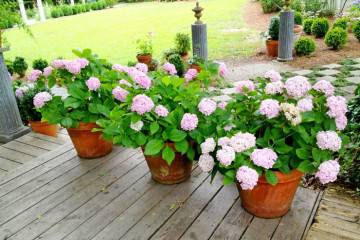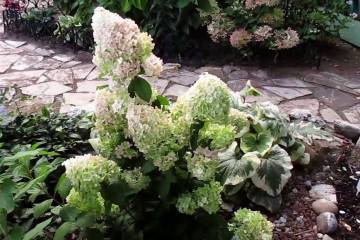Hydrangea Dolly (Dolly) - description and care
Content:
The young Dolly hydrangea variety quickly gained popularity among gardeners. A plant that does not require careful maintenance becomes a bright decoration of the site and pleases the eye with its lush panicles already in the first year of planting.
The origin and characteristics of the flower
The panicle hydrangea was first described by the German botanist Phillip Franz von Siebold. During a trip to Japan in 1929, he saw garden bushes and took their seedlings to Europe. For many years, breeders have been working on new varieties. One of the latest results of their work is the sprawling but compact Dolly.
The Dolly panicle hydrangea bush reaches a height of 1.5 m and a width of 1.2 m. The plant has strong gray shoots and a dark green spherical crown. Leaves - oblong with pronounced veins.
Blooming dolly
Thirty centimeter inflorescences in the form of cone-shaped panicles appear on the shoots of the current year. They are yellowish-greenish in color, changing to cream and white. In autumn, the four-petal flowers take on a pink-red hue. Some of the buds on the panicle remain unblown.
Dolly panicle hydrangea begins to bloom in June and pleases with lush inflorescences, exuding a delicate and sweet aroma, until the end of October.
How to transplant hydrangea after purchase
First of all, you need to buy good seedlings and choose the best place.
What you need to plant a flower
One of the most important points is the selection of seedlings. You should buy beautiful bushes about 80 cm high in containers. The leaves must be fresh, the number of buds must be at least 3. Check for signs of illness. When purchasing sick or wilted seedlings of Dolly paniculata hydrangea, there is a high probability that they will not take root.
Seat selection
The flower prefers diffused light, so planting is carried out in a shaded area (in the northern regions - in sunny places). You should choose areas protected from the winds. The bushes feel comfortable in the penumbra of conifers: thuja, fir, etc.
The plant requires fertile and acidic soil with a pH of 4 to 5 and no lime. The recommended composition is sheet soil, humus, peat and sand in a ratio of 2: 2: 1: 1.
Description of the process of planting hydrangea Dolly
Planting is done in late April-early May, or mid-October-early November. The required temperature is not lower than 15 degrees Celsius. Planting in autumn is carried out 2 weeks before frost.
Planting procedure:
- the site is dug up, cleaned of weeds and stones, moistened;
- dig a hole 30x30x30 cm in size;
- drainage is placed on the bottom (stones, broken brick);
- add phosphorus-potassium fertilizers and urea;
- the plant is placed in a planting hole (the root collar is not buried), sprinkled with earth. The distance between seedlings is from 1 to 2 m;
- the seedling is watered, mulch is spread on top (bark, needles, peat).
Dolly hydrangea propagation
The flower propagates by cuttings, layering and dividing the bush.
Cuttings
For reproduction, use the shoots remaining after the spring pruning or annual green shoots cut in the summer during the formation of buds.
Cutting technology:
- Cuttings 10 cm long with 2-4 pairs of leaves are selected. The base is cut at an angle of 45 degrees, the lower leaves are removed, the upper ones are cut in half, the bud (if any) is cut off.
- The material is soaked for 2 hours in a growth stimulator (HB101, Epin extra, etc.). Next, the cut is treated with a root stimulator (for example, "Kornevin").
- The cuttings are placed in a container with moistened sand and peat (in a 1: 2 ratio). Planting depth - 2-3 cm, distance between cuttings - 5 cm.
- Plants are sprayed and covered with a cap, placed for 3-4 weeks in a warm (18-25 degrees) and darkened place, moistened weekly.
- After the roots appear, the cap is removed, the plants are planted in pots with a mixture of peat, earth and sand (in a ratio of 2: 2: 1).
- The hydrangea is planted in a permanent place in the spring of the next year.
Some growers transplant into open ground in the fall in 2-3 weeks of frost.
Reproduction by layering
The shoot is slightly incised at the place of formation of future roots and bent to the ground, attaching it with a hairpin and partially sprinkling it with soil. Layers are provided with regular watering. After the formation of the root system, the plant is separated from the mother bush.
Dividing the bush
The process is carried out in the spring (before young shoots begin to grow) or in the fall (before frost). The dug out bush is divided into parts so that 2-3 buds and 5-6 root suckers remain on each.
Hydrangea care
Hydrangea Dolly is an unpretentious flower. To ensure growth and flowering, a number of simple procedures must be followed.
Watering
Watering is carried out as the topsoil dries up, on average once a week. The bush should have 15-20 liters of water. To retain moisture, you can distribute mulch over the root zone.
Top dressing
Top dressing periods:
- In the spring. Nitrogen fertilizers are applied to enhance the growth of shoots and roots. You can use ammonium nitrate or urea (for 10 square meters of land - 50 g of a substance diluted in 5 liters of water).
- During the emergence of buds. Phosphate-potassium fertilizers are used, for example, superphosphate (20 g of the substance is diluted in 10 l of water).
- Twice during flowering. Phosphorus additives are used (diammophos, superphosphate, etc.), dissolved in water (100 g of substance per 10 l). For every 1 sq. m of land - 20 g of fertilizer.
- In the fall, in preparation for winter. To strengthen the roots, the bushes are sprayed with a potassium-phosphorus mixture and the roots are watered (20 g of potassium sulfate and the same amount of superphosphate are dissolved in 10 liters of water).
Flowering care
The scarcity of inflorescences can be caused by:
- lack of light: it is necessary to transplant the plant;
- frostbite of young shoots: preparation for winter is required;
- improper pruning: excessive removal of young shoots;
- lack of nutrients: to maintain flowering from May to August, potash-phosphorus fertilizers are applied to the soil;
- alkalinization of the soil: it is necessary to check the acidity and add additives, for example, a solution of 10 liters of water and 5 g of citric acid powder.
In summer, the plant can be susceptible to diseases and pests. In the event of powdery mildew or annular spotting, the leaves are treated with a mixture of copper sulfate and soap. A soap solution, karbofos or actellic will help get rid of aphids and spider mites.
Features of care during the rest period
Adult bushes spend a dormant period on the site, and young seedlings in pots should be placed in a darkened room. The optimum temperature for hydrangeas during this period is + 8-10 degrees. Watering is practically not required, hydrangea does not need feeding.
Preparing for winter
The process of preparing for winter includes:
- removal of wilted inflorescences and old branches;
- high hilling;
- mulching the site.
Hydrangea paniculata Dolly is characterized by frost resistance. Shoots lignified by winter are able to endure cold weather without shelter. However, harsh or snowless winters can ruin flowers, so it is recommended to cover them. For this, the bushes are tied and wrapped with lutrasil (spunbond). Around them, at a distance of 25 cm, a frame is erected from a metal mesh, exceeding the height of the bush by 10 cm and filled with dry leaves. With the onset of heat, the structure is removed.
Hydrangea Dolly is a bright decoration of the site. It becomes a central element of garden design, delighting with its lush panicles from early summer to autumn.




















